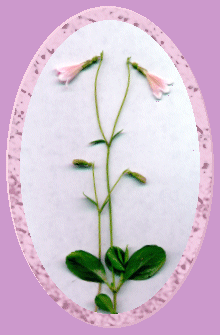|
The shy twinflower is one of the most easily missed wild plants in this area--until late spring, that is, when masses of the tiny blossoms fill our woods with one of the most delightfully clean and inviting scents ever known.
Throughout most of the year, this native plant is an unobtrusive creeping shrub, with branches that are seldom more than a couple of inches above the ground. It is rather slow growing, yet extends its "circle of influence" a few inches a year if undisturbed. For a few weeks in May and early June, however, it comes into its glory--thrusting up pairs of delicate bell-like pink flowers on fragile, slender 3 or 4 inch stalks all along its sturdy brown stems.
It is actually an excellent groundcover in its non-flowering state because the dark, almost succulent small green leaves are eye-pleasing and sturdy. And its slow-growing habit encourages it to grow rather densely rather than sprawling around. Even before I recognized that this wild "groundcover" was actually the plant that produces twinflowers, I left it wherever I found it in our yard because of its subdued attractiveness.
When we moved to this area, I noticed that in late May the breeze would often carry from the woods a beautiful scent that was sweet and light. It wasn't quite the scent of blackberries or fir; it was lighter than lilac, let alone rose. And I couldn't see anything that could possibly be giving off this heavenly scent. I assumed my elderly neighbor must have planted something in her prolific garden that sent its scent my way. So I just accepted it as a gift on the wind!
A few years later, when he was enthusiastically investigating the native flora of this area for a major botany project, my son identified this perfume's source as these wonderful dainty blossoms. We hadn't considered that such a diminutive flower could possibly send forth so much aroma--but it was indeed our source! The flowers transform this sedate groundcover into a miniature fairyland of aroma and beauty that can be enjoyed by getting down to its level (wide-eyed and breathing deeply!).
These flowers are best appreciated on the plant, for they are so tiny and fragile that they don't last as cut flowers (what a tiny vase would be needed!) and they don't dry well. They are beautiful, indeed, but I had to enlarge my main image so that they could be seen; they are actually closer to the size of those on the side border on this page. But they smell "big!"
The ultimate compliment? The great botanist Linnaeus, who was responsible for ordering and naming most of the familiar plants we now know, gave his own name to this plant because it was so close to his ideal of what a flower should be. Can't do much better than that!






|








